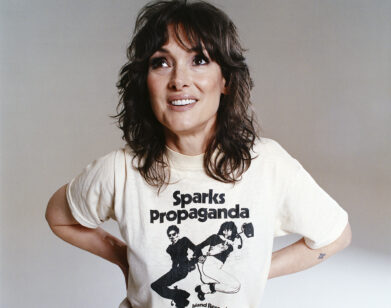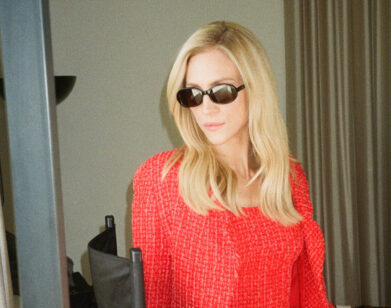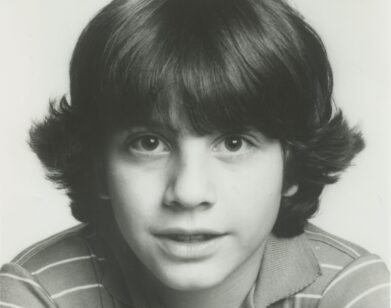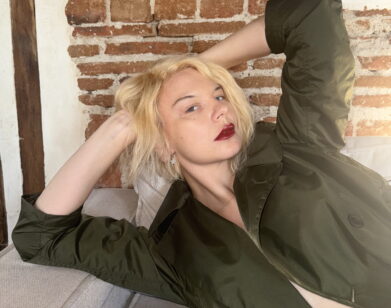In Conversation
Hayley Atwell on M:I 7 and the Secret Behind Tom Cruise’s Running
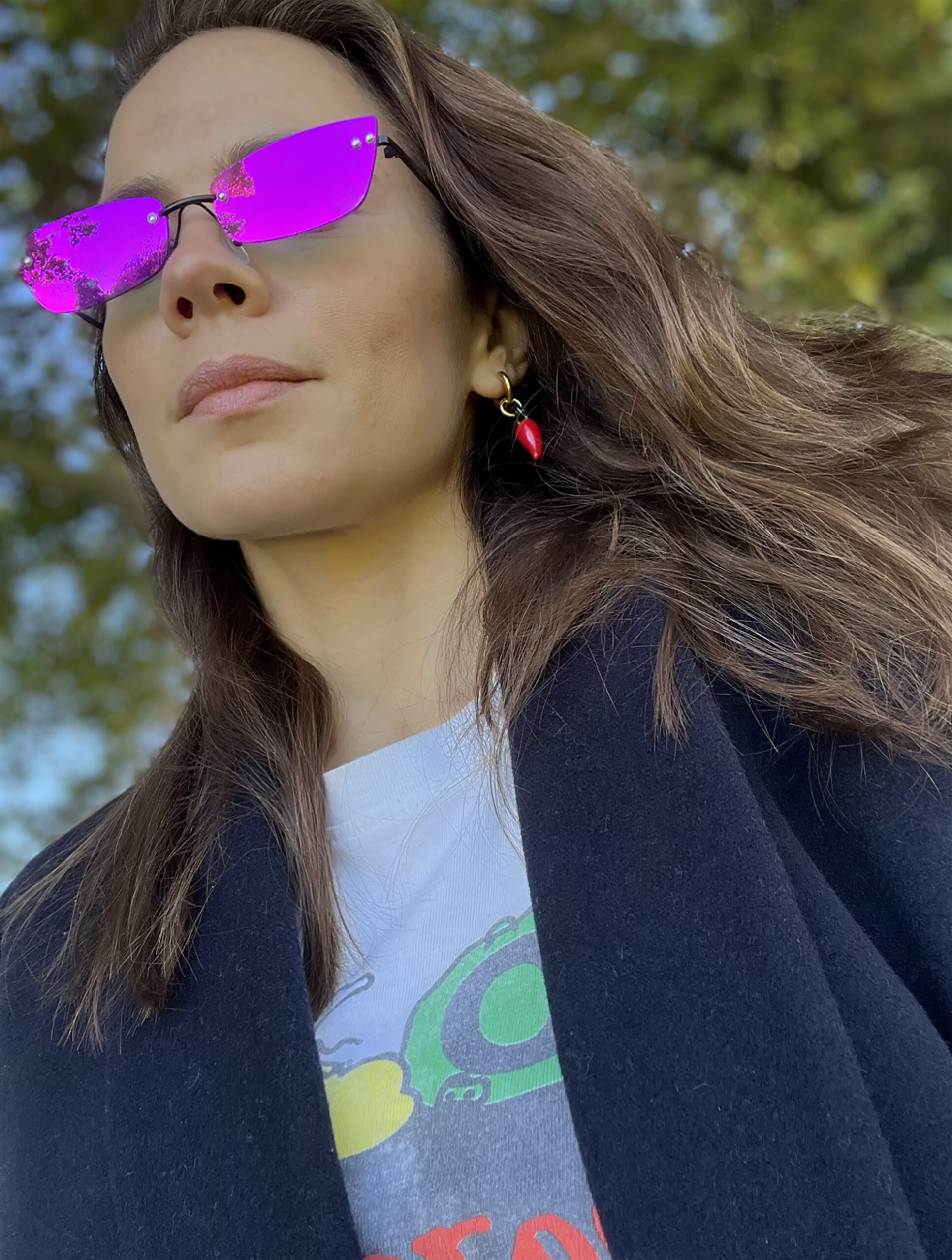
Hayley Atwell is a veteran of the West End, the British television industry, and the Marvel Cinematic Universe. But it wasn’t until she was cast in this summer’s Mission: Impossible – Dead Reckoning Part One that the 41-year-old British actor was tasked with her greatest challenge yet: keeping up with Tom Cruise. Before she embarked on a global press tour to promote the summer’s most anticipated blockbuster, Atwell got on a call with her friend, the actor James D’Arcy, to talk about preparing for the physically demanding role, why making the movie was the ultimate film school, and the secret behind Tom Cruise’s maniacal running.
———
HAYLEY ATWELL: You look so sophisticated with your wall of books, your culture and your intelligence behind you.
JAMES D’ARCY: They’re not actually books, it’s all made out of wood.
ATWELL: It’s a front.
D’ARCY: It’s just a front, like the rest of my life. So this afternoon, I’m playing the role of a hard-boiled journalist. I won’t be taking no for an answer and there’ll be no skimping round the edges with your answers.
ATWELL: I’m ready. My phone’s off.
D’ARCY: You go the extra mile. Speaking of which, how many miles have you gone today in preparation for the stunts that you do in Mission: Impossible?
ATWELL: Good question. Currently, I’m running about 30K a week. I did a 5K run this morning and then some Pilates mobility strength training.
D’ARCY: I saw that on Instagram. It looks ridiculous.
ATWELL: Some people thought it looked like a medieval torture contraption.
JAMES D’ARCY: It does.
ATWELL: But yes, I’ve done my 5K today, I’ve done my Pilates with Sam Eastwood, and what I’ve loved about working with her is that all the training I did had to do with creating physical behaviors that could then be incorporated in any kind of fight sequence or drifting-in-a-car sequence. It wasn’t that we were chasing a particular aesthetic for Grace, my character—it was getting to me to a point where I could be dynamic enough and safe enough to try a ton of different things and see what looked most effective and exciting for the audience.
D’ARCY: Did you say to Sam and all the other stunt people when you started, “Look, obviously I don’t want to get injured, I want to do as many stunts as I possibly can myself, but mainly what I want to do is run faster than Tom”?
ATWELL: Well, bearing in mind I’m in high heels and I’m also handcuffed to him, just being able to not fall flat on my face was the initial goal.
D’ARCY: Does he run as fast in real life as it looks like he runs when you watch the movies?
ATWELL: Yes, but what I’ve noticed on set is it’s not his speed that’s the most impressive. He’s studied the form, he’s studied how to run. So when he’s running, it feels like it’s with every cell in his body, as if he’s running towards the thing he wants to save and also running away from a bear. There’s not a lazy foot or a turned in knee at any point, and it creates this form that’s really beautiful to watch because it’s anatomically correct. It’s kind of amazing because you think some people might be faster than him, but he runs with such an urgency where you feel it.
D’ARCY: Is that what he said to you? “Just so you know, when I’m running, I’m always imagining a bear.”
ATWELL: I imagine he’s probably running away from journalists.
D’ARCY: Journalists like me, hard-boiled.
ATWELL: At one point I was running in the park and Sam said, “Well, they’ve now decided that they’ll have you running beside him,” and I went, “What? On roller skates? How the hell am I going to do that?” But then when they said, “You’ll be in high heels and you’re handcuffed,” I was like, “Okay. Well, I don’t have to catch up with him then. I just have to try and match his energy.” And he’s very safe, so he’s always making sure that I’m not going to fall flat on my face behind him. There’s a train sequence, and it begins with the train carriage vertical and we are standing on one end of it. It takes six seconds for this real-sized train carriage to go to horizontal to vertical, so on “action,” we would have to run up a very steep incline just in time to hold onto a bar, where we’d be suspended with a ravine below us. And we did it about six times, and I was puffing and panting, and they said, “We’re going to go again.” And so we went back down and Tom looked at me, and I could see in his eyes that obviously what he was looking back at was someone who’s probably in a bit of a frazzled state. And he was like, “You okay?” And I just remember going, “I don’t know. I don’t even know what I don’t know.” And he said, “I think you may have adrenal fatigue,” and I was like, “Okay.” And then he went, “Do you want some chocolate?”
D’ARCY: He produced some from his back pocket.
ATWELL: Within about 30 seconds, a beautiful box of raw dark chocolate arrived on set and I wolfed it down, and then we went again and I was faster, sharper, with a smile on my face.
D’ARCY: In Master and Commander, I had to climb to the top of the ship, and of course because you’re on a ship, it’s a pendulum. At the top, it feels very windy. And the other person up there with me was Russell Crowe, who was exemplary, like Tom, in terms of making sure that I was safe and okay. We were harnessed up, and he looked at me and went, “James, can you see my harness?” I sort of looked down and went, “Well, yeah, but they’ll paint that out.” And he went, “No, it’s not good, mate. Take it off me,” because he couldn’t take his own harness off. And I was like, “What?” He said, “Take the harness off me.” So I’m taking his harness off at the top of this ship and I’m, by the way, harnessed in twice. He refused to climb it with a harness, so then he clipped in when he got there, was unable to take it off himself, and insisted that I took his harness off. And as I was doing it, I was thinking, if Russell falls off and dies, am I an accomplice in his death? Anyway, he didn’t.
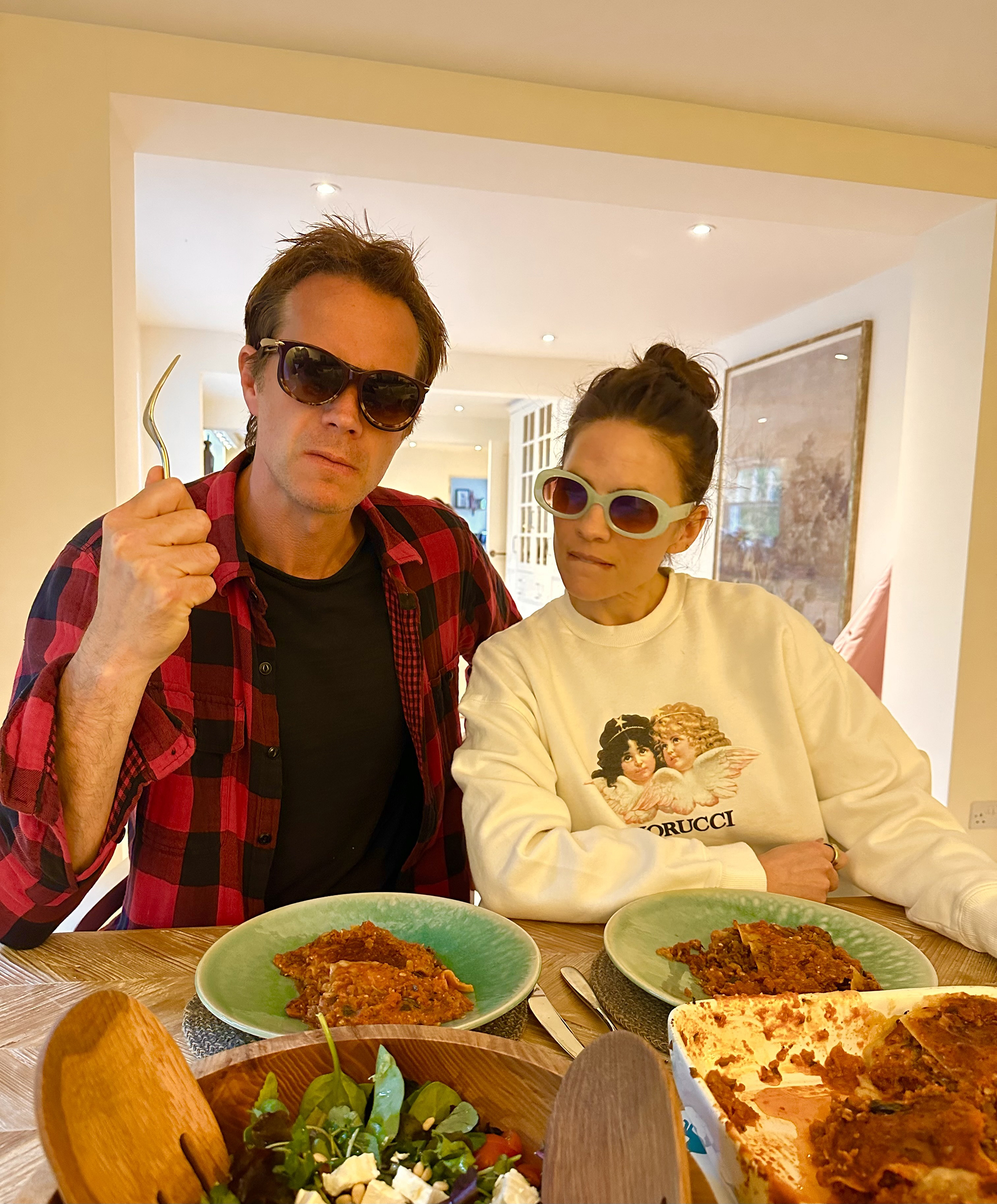
ATWELL: It’s like when I had my harness put on, you’ve got to pull your pants down in the middle of a set. You’ve obviously got your long johns on underneath, but it sort of feels a bit like your mum’s changing your nappy while you’re standing there. It’s a very humbling experience.
D’ARCY: It is a weird thing, isn’t it? Because there’s some part of you that thinks glamor, glamor, glamor. And yes, there is a bit of glamor, but so often you are standing there in your pants next to Tom Cruise having your harness adjusted thinking, “I just want the earth to open up and eat me.”
ATWELL: I think being on a film set, you have to leave your ego at the door because the things you end up doing are things that probably only your family has seen you do, and you have to create this trust where you can be dripped on by someone else’s sweat, from the person that you’ve only met a few weeks before, and it gets you’re in the trenches with them quite quickly.
D’ARCY: Or you walk onto the set to do the kissing scene and your kissing partner shows up, and they go, “I’m really sorry, I’ve got a terrible cold,” this is pre-COVID, and you’re like, “Okay,” because there’s no way around it.
ATWELL: That was the other extra challenge, COVID. The protocols were so strict.
D’ARCY: You basically couldn’t see anybody or go anywhere. You were ferried to the set and back from the set, and then you were in a hotel room.
ATWELL: Yeah. At one point Tom was doing his own hair and makeup in Venice, so he would be like, “Is it okay? Do I need powder?”
D’ARCY: That’s amazing. That film was such a big deal for the industry when you were shooting it because it was possibly the most visible film being shot over COVID, and obviously employed hundreds of people around the globe. I remember just from talking to you, but also I think it was in the press that McQ and Tom were absolutely determined that you guys were going to show the industry that it was possible to keep shooting through these difficult times.
ATWELL: Yeah, absolutely. It wasn’t just our film, but Tom would be on the phone to studios, other productions, sharing how they problem-solved and worked around it to keep an ongoing working environment so that, like you said, hundreds of people can retain their jobs and it can have a feeling of momentum within very strict safety regulations. And because we’d never seen anything like this before, you had to make up what those things were. There wasn’t the textbook of when there is a pandemic, this is how you do a film of this size. And even things like when we worked in Norway, we all lived on a boat so that we weren’t in town disrupting anyone’s lockdown life. It was like we were this traveling circus in our own isolated bubble, and we knew also that all eyes were on us because of Tom’s brand and the size of this franchise.
D’ARCY: I’m going to switch gears a because I know you as a goof. When we worked together on Agent Carter, I always felt like you were quietly thinking about ways to, in the nicest possible way, trip me up, whether that be scaring me at lunchtime or on Halloween. So what I want to know is how long did you have to hide in Tom’s trailer on Halloween in order to scare him, and how did you get in there?
ATWELL: I couldn’t penetrate the compound, so I just picked on Simon Pegg instead.
D’ARCY: It was literally Mission: Impossible.
ATWELL: It was. But with pranks, it’s important to state I don’t like cruelty or anything that is mean. You have to test the waters to see if this is something someone will actually enjoy, and once that permission is granted, then it’s fair game.
D’ARCY: Did you prank Tom? And when he gave you his famous Christmas cake, which I know he did because you gave me a slice of it, did you give him a bit of the Hayley Atwell famous Christmas cake?
ATWELL: What’s that?
D’ARCY: It doesn’t exist.
ATWELL: Well, he doesn’t eat sugar.
D’ARCY: On a big film like Mission, how much room is there for playfulness, creativity, and permission to fail?
ATWELL: Great question. In the screen test, both McQ and Tom said, “Look, we haven’t got a script and we don’t have a character written, so we don’t know what we’re looking for until we find it, but we want to find the actress we want to work with, and then we will together in real time throughout the course of filming write that character based on what you give us.” Some people might find that terrifying, like, “Does that mean I’m auditioning all the time?” But because they’re such gentlemen and you feel that they’re on your side, you can’t fail because there is that safety net of knowing they’re only going to use the things at work. Tom would never say something was good or bad, it would just be different choices, offering up different things. And because they’re so transparent with their process, Tom might do something and be like, “I didn’t like that, it didn’t work,” or he’d watch playback and go, “I thought it was going to read in one way, but what I’m not feeling is this beat that we’re missing. Let me try something completely different.” And because he didn’t bring his ego to the set and neither did McQ, they’re working it out as they go along, very much trying to have an objective beginner’s eyes on it all the time.
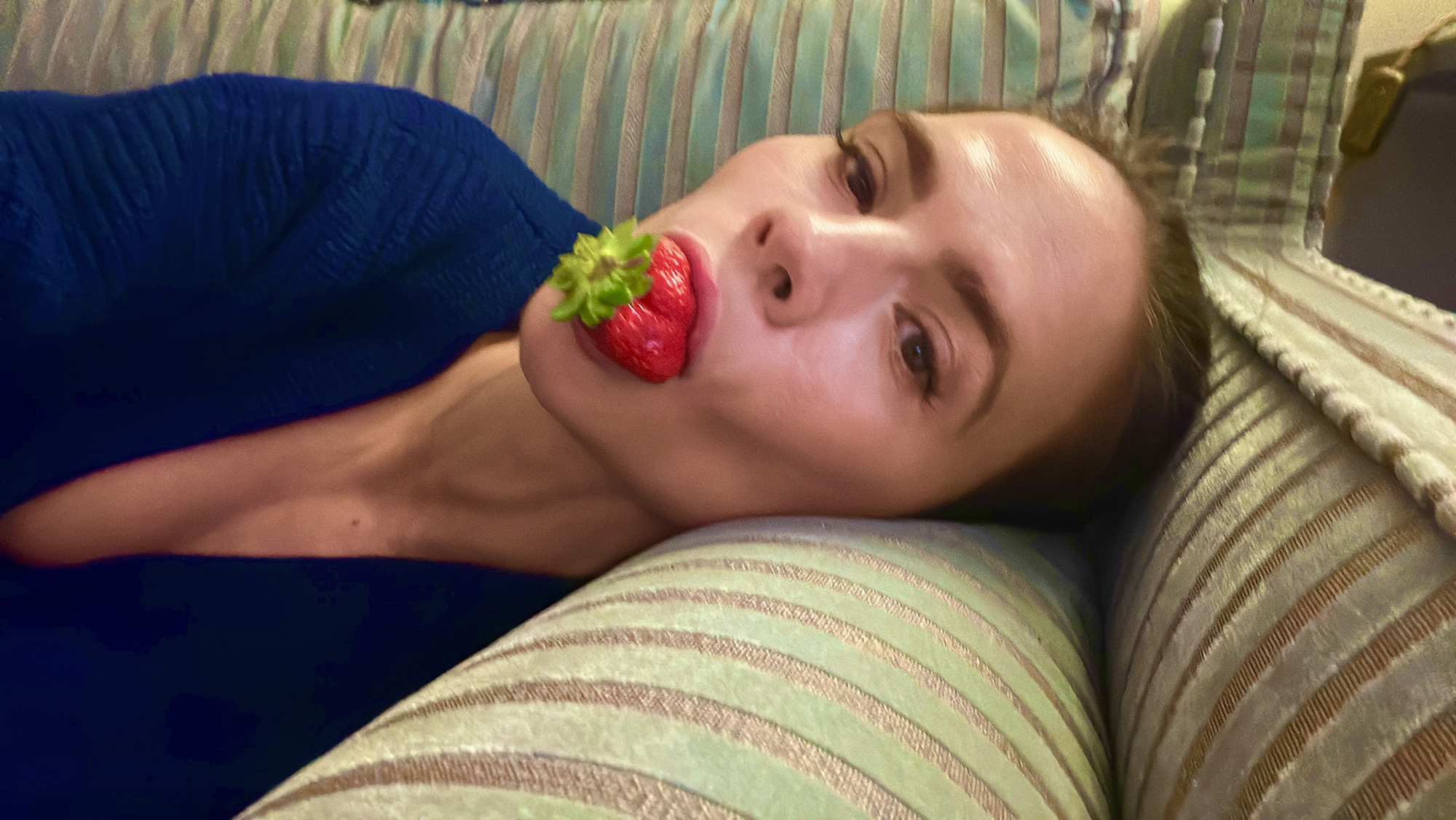
D’ARCY: That’s what I wanted to ask you next. You said that Tom would watch playback and then say, “That’s not quite reading the way I thought it would. Let me try something else.” But of course, he’s Tom Cruise. Did they afford you the same freedom?
ATWELL: Uniquely, it was the latter. And because that was happening quite early on, it meant that I built up more and more confidence to try and look at my own work objectively. There was one scene, it was a bit of a monologue and the camera was right in front of me, and my character is quite tired and vulnerable. I did it a number of times, and McQ and Tom were there, and we looked back on playback, and for me it wasn’t working. Maybe 10 years ago I would’ve been like, “I’m not good enough. It’s me.” But this time it was like, “I don’t know how to make this work, let’s look at it technically.” And McQ just went, “I think the camera’s in the wrong place because we have a camera that’s right in front of you. It’s a kind of confrontation with the audience because the audience is looking directly at you.” But if the camera was moved slightly above and to my side, two things are happening. With the camera moving high, it creates a sense of pressure over the character who in the frame is looking smaller, so that instantly makes her appear more vulnerable without me having to do anything. Secondly, with it slightly more to the side, the audience is with me and they’re starting to see the rest of the room the way that my character is seeing the room. So their visual is relating to my character’s perspective rather than me trying to be interrogated by the audience and make them feel a particular thing for her. It was a revelation to me.
D’ARCY: What a film school for you. So often as actors, you arrive on set and the camera is where it is and you do the scene, but nobody says to you, “This is the reason we’re putting the camera here.”
ATWELL: I’ve been used to working more with directors who will come in and we’ll talk about the psychology or the inner-world of the character. That can be really useful, but also that feels more like that’s my internal job, to bring a rich inner world and naturalism and an understanding of what my character wants in that moment, what the obstacle is, and playing with those. And you’re right, they like the communication of explaining what’s being picked up on the lens.
D’ARCY: It’s 50 percent of filmmaking. Of course you have to find the emotion and you have to be authentic, but the camera can do so much for you.
ATWELL: Understanding the camera, understanding what the lenses do, understanding what the composition of the frame is doing and what that’s communicating. And for me, that’s the work as a film actor to know. It’s developing a relationship with the DP so that I know what the camera’s picking up. There’s shots where I’m running across a moving train and I can feel the camera that’s on a crane that’s trying to move at the same speed as the train, so I’m sensing when it’s turning to get me in profile and therefore, how long I have to keep in frame for that shot before I go out of it. And that is everything. It’s knowing that the camera is your friend, and there’s no point having this incredible, deeply moving, beautiful performance if the camera’s way over there and you can’t see any of it.
D’ARCY: It’s a dance, isn’t it?
ATWELL: It’s a dance, exactly.

